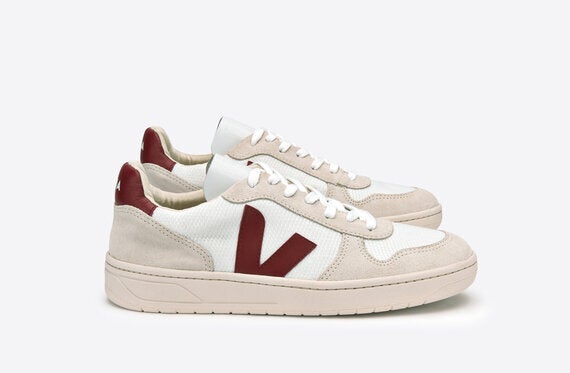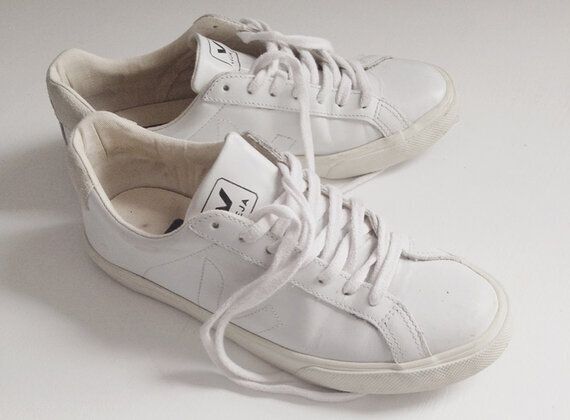They've been around for more than a decade, yet the past few years have seen a marked increase in Veja soles on the ground. If you're unfamiliar with the name, you're certainly not alone. They're known for operating below the radar. Unlike their competition, they do not engage in any form of traditional advertising, relying mainly on word of mouth from their devoted fan base.
Having successfully navigated the warren of outside corridors and coded doors of Paris's 4th arrondissement, I found myself at their headquarters, eager to discover their story...
Veja was founded in 2004 by two 'normal' French guys, Sébastien Kopp, co-founder of the brand tells me. What exactly does he mean by 'normal', I asked? 'We're not mathematicians, scientists, philosophers - we are kind of normal guys', he explained. They began their brand with neither a huge amount of knowledge of the industry nor a lot of money, but simply a good dose of strong will and belief in their project.
And 10 years on, the brand is stronger than ever. But, he assures me, like any company, they've had their ups and downs. Most notably they have managed to weather the waves of greenwashing that have seriously damaged some of their peers.
In a nutshell, 'greenwashing' is essentially when you pretend to be, or pretend to be doing something that you're not. More specifically, from an environmental standpoint.
'We were not hurt' Sébastien said, 'because we were not saying very loudly what we were doing - the information was there, but we never pushed it.' Their idea from day one was to merge 'social impact, economical impact and environmental impact in one project'.
Today another wave of greenwashing has arrived. 'In the economy, in the society, in the social world we live in, everything is linked. And this idea has grown a lot in the heads of the public in the last years.' This wave 'is bigger and faster', he adds.
Communication levels have moved on considerably since the brand launched 10 years ago. Today you cannot say one thing and do another without being exposed, and fast.
They created Veja to inspire others to believe that this concept of the triple bottom line (people, planet and profit), was possible. So successful have they been that the great and the good are knocking at their door for advice.
But success has by no means blinded them to their shortfalls. 'What we are, what we want to do, is to stay very strong in our principles - to go always further than the day before', Sébastien adds.
Case in point: their journey to discovering an alternative to using leather.
When they first designed their sneakers, they used only organic cotton but soon realised that it wasn't ideal for the winter months. Their latest development to keep our feet warm but sweat free is their B-mesh fabric. Made using 100% recycled plastic bottles, (the equivalent of 3 bottles are used for the B-mesh panels of an adult shoe) it is both breathable and insulates at the same time. Better than cotton for colder weather but less so than leather, as it stands. 'We know leather is not an ecological product but we have not found a really ideal replacement yet - this is one of the limits of Veja.'

V-10 B-mesh sneakers, image courtesy of veja-store.com
As a vegan himself, Sébastien is keenly aware of the challenges of working with leather. But he's also aware of the statistics. Leather is a "by-by-by-product" of the meat industry. It is the end of the chain and if it remains unused, it's simply thrown out. 'If you want to change the world, you stop eating meat. You will change it... Not wearing leather is a symbol, it is not a means to change the planet.'
The construction of Veja sneakers from raw material to finished product is a fascinating one, from their encouragement of agroecology and employment of traditional farming methods at the start of the chain, to their zero stock strategy at the end.
The manufacturing cost of Veja sneakers is 3 to 4 times higher than their market competitors, but we get to buy them at the same price. How? It's all in the advertising, or lack thereof. They prefer to invest in their production chain rather than in a glossy ad.
The company is not large. They directly employ about 20 people. And there is a reason for this. Sébastien says 'We don't want the company to be bigger than the project - because then you lose everything.' They strive to grow organically and they do not look for investors which, he concedes, makes them a 'strange' type of entrepreneur.
While they directly employ only a small group, they collaborate with many more worldwide, from cotton farmers in north east Brazil, seringeiros (or rubber tappers) in the Amazon and shoe manufacturers in the south of Brazil, to working with the Atelier Sans Frontières association in Paris. And the word 'collaborate' is important here. I mistakenly said their model had scope to 'help' people. 'We do not help people', said Sébastien (this point is emphasised by a fairly uncomfortable silence). They all work together, and this is a very strong principal inside Veja.

Always a fan of a classic, my Veja choice
'Veja' means 'look' in Portuguese. Look at what you are buying. How is it made? Who made it? Under what conditions?
'Invest yourself in the looking and you will see' Erik Joule recently said, and trust me, there is always so much more beneath the surface.
This post was originally featured on the study 34 blog.
